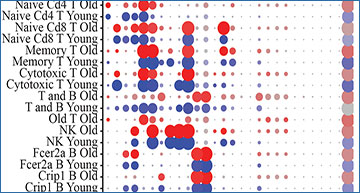Compositional and transcriptional changes in the hematopoietic system have been used as biomarkers of immunosenescence and aging. In this new study, researchers from Brown University used single-cell RNA-sequencing to study the aging peripheral blood in mice and characterize the changes in cell-type composition and transcriptional profiles associated with age.
“Here, we applied scRNA-seq on young and old mice to dissect the transcriptional and cell composition changes of all cell types in the peripheral blood with age.”
The team identified 17 clusters from a total of 14,588 single cells. They detected a general upregulation of antigen processing and presentation and chemokine signaling pathways and a downregulation of genes involved in ribosome pathways with age. In old peripheral blood, the researchers also observed an increased percentage of cells expressing senescence markers (Cdkn1a, and Cdkn2a). In addition, a cluster of activated T cells exclusively found in old blood was detected, with lower expression of Cd28 and higher expression of Bcl2 and Cdkn2a, suggesting that the cells are senescent and resistant to apoptosis.
scRNA-seq of young and old blood identifies different cell types
(A) t-SNE visualization of 14,588 old and young peripheral blood cells. (B) t-SNE visualization of the 17 clusters of peripheral blood cells. Memory T: Short-lived effector memory T cells; T and B: Proliferating T and B cells; NK: Natural killer cells; Fcer2a B: Fcer2a, Sell, Ccr7 B cells; Crip1 B: Crip1, S100a6 B cells; Vpreb3 B: Vpreb3, Spib B cells; Zcwpw1 B: Zcwpw1, S100a6 B cells; Mono: Classical monocytes; DC: Monocyte-derived DC; Mk: Megakaryocytes; Mθ: Macrophage; RBC: Red blood cells. (C) Marker genes for each immune cell type and the corresponding clusters.
“Finally, targeting senescent cells using genetic approaches has been shown to ameliorate the aging phenotype. More recently, senolytics drugs are being identified or developed to target apoptotic pathways because senescent cells are known to be apoptosis-resistant. Therefore, the Bcl2+ old T cells that we identified in old mice can potentially be targeted pharmacologically to ameliorate the phenotypes associated with the aging of the immune system.”
Source – Aging
Teo YV, Hinthorn SJ, Webb AE, Neretti N. (2023) Single-cell transcriptomics of peripheral blood in the aging mouse. Aging (Albany NY) [Epub ahead of print]. [article]




